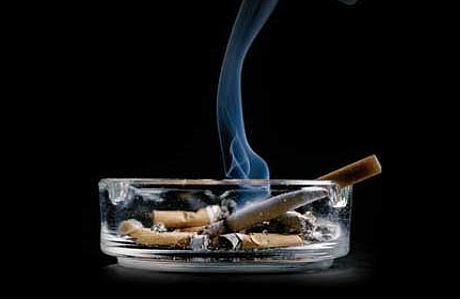America is a country that many revere for its accomplishments and advances in such fields as medicine, technology and military power. It isn’t all stellar news though: America has its fair share of negative reports. One is the well-documented case that it has the highest rate of obesity anywhere in the world, another that it spends more per person on healthcare in the developed world but also ranks last in effectiveness of healthcare in the developed world also. And the latest finding that America would rather stayed a secret is a recent report from the World Health Organisation which shows that America leads the world in smoking-related deaths.
The report shows that of the deaths occurring in the USA, a whopping 23% are supposedly linked to smoking, while Japan and France, renowned as amongst the heaviest smokers on the planet, have 12% and 5% respectively. China, another country with high smoking rates, was spoken of in the report thusly: “The results for China were also interesting with crude proportions of death attributable to tobacco being 12% for men and 11% for women.”
On the surface, these figures are troubling and highlight the need for America to work harder on stamping out the habit. However, a little further analysis portrays a wholly different picture. How is it that a country with a relatively low smoking rate takes the top spot for smoking-related deaths? In fact, 23% is not only the highest in the world but almost twice the global average of 12%. Not only do Japan and France have lower rates of smoking-related deaths than America, they both have higher rates of smoking and lower rates of mortality as a whole. This begs the question: How is it that the people of these countries smoke more, live longer and suffer fewer illnesses related to tobacco? It isn’t the case that these are countries with a life expectancy low enough for the population to die before reaching an age that cancer can kill them – Japan does after all have one of the longest life expectancies in the world. While it has been hypothesised that the Asians have a degree of resistance to lung cancer, this has not been said of other continents and so cannot apply to those in Europe. The vast geographical distance and huge difference in lifestyle between these countries further confuses this issue.
The figures suggest interesting places to focus future research – could it be the type of tobacco Americans smoke that causes the problem, or the way it is cured? Could it be certain additives that American tobacco companies are adding to their cigarettes that other countries do not? Either of those is possible, but it could also be a simple case of miscalculation.
While everyone knows that “smoking-related diseases”, despite their name, afflict non-smokers too, and can be caused by things other than smoking – such as diet, lifestyle and genetics – a number, if not all, of the American states have a check box on the death certificates to state whether tobacco was a primary or secondary factor in the cause of death, and some states have the requirement to tick the box simply if the deceased smoked. In at least some of these states, it isn’t a case of the physician’s final say, but a simple mandatory requirement that if a person smoked and died of a certain disease, they are automatically categorised as a death resulting from smoking. What this means is that a morbidly obese person with a sedentary lifestyle, appalling diet, a genetic history that predisposes him or her to a heart attack and who also smokes will be put down as a smoking-related death – even though there’s a very high chance that any of the numerous lifestyle factors, or indeed genetic history, could have been the real cause of death. This bolsters the number of deaths associated with tobacco, which is ideal for anti-smoking campaigners who can use such numbers to secure further funding to continue their campaign, but in a more objective view, such as the WHO report, it is rather alarming and also detrimental to a real understanding of worldwide health priorities.
America has the largest anti-smoking campaign in the world, and a lot of money is spent at the state and federal level to facilitate it. In 2001, Tobacco Control received $883 million solely from the Master Settlement Agreement – an agreement whereby the tobacco companies paid money to each of the American states to recoup the medical bills of treating smokers. While the $883 million to Tobacco Control will likely be somewhat lower today as part of that money is redirected to other essentials, the anti-smoking movement still commands hundreds of millions of dollars a year. The pharmaceutical industry donates hundreds of millions of dollars to anti-smoking organisations and to back smoking bans in an attempt to encourage smokers to move from tobacco to their own nicotine replacement therapies. Much money is also raised from and donated by the prominent cancer, lung and heart charities. To emphasise the sway held by these groups, in Texas one such foundation has threatened that if the Texas University does not ban smoking on the entire campus, both indoors and out, then it will give its $10 million grant money to another institution – and when the funding group has that sort of leverage over the receiver, there’s never any doubt as to what the results of any grant-funded research will be.
While it’s not easy to determine if America’s unusually high mortality rate from smoking is based on real deaths or falsifying the numbers, it is more than a little peculiar that a country with smoking rates as low as America can have death rates that are so high. The mandatory requirement of classifying any death of a smoker as a smoking-related death may work well for increasing the bank balances of anti-smoking groups, but it does a tremendous disservice to science and true world health efforts as whole. Perhaps if the figures were calculated in the same way as they are in other countries, the percentage would drop considerably.
| Russia
|
4% |
| France | 5% |
| Brazil | 6% |
| Italy | 7% |
| Germany | 9% |
| China | 11% |
| Japan | 12% |
| GLOBAL AVERAGE | 12% |
| Australia | 14% |
| United Kingdom | 20% |
| Canada | 20% |
| USA | 23%
|


